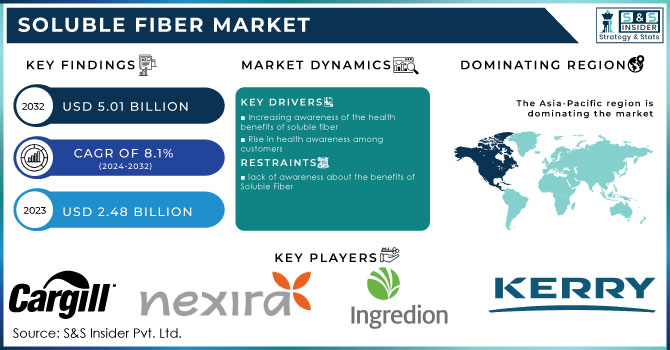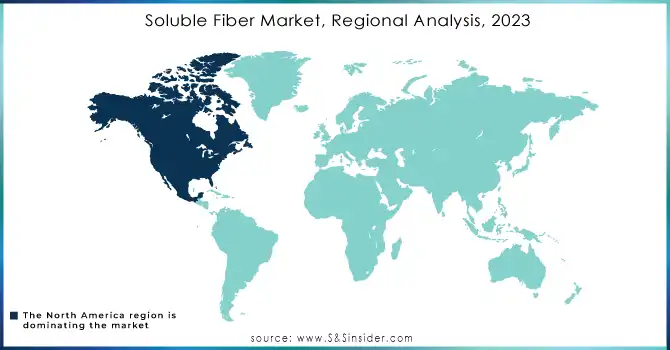Soluble Fiber Market Key Insights:

Get More Information on Soluble Fiber Market - Request Sample Report
The Soluble Fiber Market size was valued at USD 2.48 billion in 2023 and is expected to grow to USD 5.01 billion by 2032, with a growing CAGR of 8.1% over the forecast period of 2024-2032.
Dietary fiber that dissolves in water is known as soluble fiber. Various plant-based foods, such as fruits, vegetables, whole grains, and legumes, contain it. Soluble fiber is well known for its health benefits.
Based on Type, the market is categorized as Pectin, Inulin, Beta-glucan, Polydextrose, and Others. The "pectin" type is anticipated to generate a sizable amount of income over the course of the forecast period due to its use in the manufacturing of jam and jelly and its active ingredient in lowering blood cholesterol.
Based on Application, the market is segmented into Food & Beverages, Animal Nutrition, Nutraceuticals & Pharmaceuticals, and Others. Food & Beverages is estimated as the major segment with rising awareness of the potential benefits of soluble fiber the market is driven by the consumption of soluble fibers. Also, Pharmaceuticals is a growing sector where it is used as a medical supplement.
MARKET DYNAMICS
KEY DRIVERS
-
Increasing awareness of the health benefits of soluble fiber
Soluble fiber has been proven to offer a variety of health benefits, including lowering cholesterol, lowering the risk of heart disease, stroke, and type 2 diabetes, and assisting with weight management. As consumers become more aware of these benefits, they are increasingly seeking soluble fiber-rich foods and beverages. As consumers become more aware of these benefits, they are increasingly seeking soluble fiber-rich foods and beverages. This is increasing demand for soluble fiber components as well as soluble fiber-fortified food and beverage products.
-
Rise in health awareness among customers
RESTRAIN
-
lack of awareness about the benefits of Soluble Fiber
the lack of awareness of soluble fiber is not often discussed in the media or by healthcare professionals. This is likely because soluble fiber is not a drug or supplement, and it cannot be patented. As a result, there is no financial incentive for companies to promote soluble fiber.
-
lack of availability of soluble fiber products
OPPORTUNITY
-
Increased issues of constipation and digestive problems
Soluble fiber dissolves partially in water, forming a gel-like material. Soluble fiber can be found in barley, oats, beans, rye, apples, and oranges. Constipation is the most prevalent digestive disease in the United States, affecting around 15% of the population, according to the Journal of the American Medical Association. Bloating, diarrhea, and gas are common digestive issues that impact millions of Americans yearly. A type of dietary fiber that dissolves in water to form a gel-like substance is soluble fiber. The rising prevalence of constipation and digestive issues is driving demand for soluble fiber ingredients and fiber-rich food and beverage items.
CHALLENGES
-
High cost of soluble fiber products
Soluble fiber ingredients are more expensive than other types of dietary fiber, such as insoluble fiber. This is due to the fact that soluble fiber components demand more intricate processing and purifying procedures. Foods and drinks high in soluble fiber are sometimes more expensive than those high in non-soluble fiber. For some customers, the high price of soluble fiber products makes them unaffordable. Even though they are aware of the health advantages of soluble fiber, consumers who are on a tight budget could be less likely to buy soluble fiber products.
-
Food safety standards
IMPACT OF RUSSIA-UKRAINE WAR
Russia and Ukraine are major suppliers of agricultural products such as grains, oilseeds, and legumes, all of which are raw materials utilized in the production of soluble fiber. The war hampered these countries' production and exports, resulting in higher pricing for soluble fiber components. The battle has also resulted in a decrease in the supply of soluble fiber components. This is owing to production and export disruptions, as well as increased demand from other countries. According to the Food and Agriculture Organization of the United Nations (FAO) report, the war might reduce world wheat production by much to 5% in 2022.
IMPACT OF ONGOING RECESSION
The recession has impacted the soluble fiber market as the recession has led to an increase in prices of agriculture commodities by 30% since the start of war. Also, the Russia-Ukraine war has led to disruption in the supply chain of agriproducts in Europe, the US, and other countries. Consumers tend to spend less on luxurious items like taking nutraceuticals and eating at the restaurants. Also, lack of awareness of soluble fiber already impacted the market growth and the recession fuelled the prices of soluble fibers by 20% in 2022.
MARKET SEGMENTATION
By Type
-
Pectin
-
Beta-glucan
-
Polydextrose
-
Inulin
-
Others
By Source
-
Fruits & Vegetables
-
Cereals & Grains
-
Others
By Application
-
Animal Nutrition
-
Food & Beverages
-
Nutraceuticals & Pharmaceuticals
-
Others
REGIONAL ANALYSIS
North America is the largest market for soluble fibers in 2022 and is predicted to grow at a CAGR of 5% in the forecasted period. This growth is due to the rise in awareness associated with the potential benefits of health issues. The United States is likely to account for 7.9% of the total sales of this region. Almost all of the major food businesses, as well as many regional and smaller producers, are adding fiber to their products to help Americans meet the recommended daily fiber consumption of 25 to 30 grams.
The Asia Pacific soluble fiber market is predicted to grow at a CAGR of 5.4% in the forecasted period. Consumers in the Asia Pacific region are becoming increasingly aware of the health benefits of soluble fiber. The major market is driven by China and Japan. In China, soluble fiber is produced by enzymatic reaction from the cellulose part of cabbage waste from China.
Europe has a significant market for soluble fiber globally as it is estimated to grow at a CAGR of 4.4%. The United Kingdom market has a revenue growth rate of 8.4% during the forecasted period. The key factors driving growth in the European market include the increasing awareness of the health benefits of soluble fiber, the growing demand for functional foods and beverages, and the rising popularity of plant-based diets.
South America, the Middle East and Africa, are also expected to witness growth in the soluble fiber market in the coming years. However, these regions are expected to account for a smaller share of the global market.

Need Any Customization Research On Soluble Fiber Market - Inquiry Now
REGIONAL COVERAGE
North America
-
US
-
Canada
-
Mexico
Europe
-
Eastern Europe
-
Poland
-
Romania
-
Hungary
-
Turkey
-
Rest of Eastern Europe
-
-
Western Europe
-
Germany
-
France
-
UK
-
Italy
-
Spain
-
Netherlands
-
Switzerland
-
Austria
-
Rest of Western Europe
-
Asia Pacific
-
China
-
India
-
Japan
-
South Korea
-
Vietnam
-
Singapore
-
Australia
-
Rest of Asia Pacific
Middle East & Africa
-
Middle East
-
UAE
-
Egypt
-
Saudi Arabia
-
Qatar
-
Rest of Middle East
-
-
Africa
-
Nigeria
-
South Africa
-
Rest of Africa
-
Latin America
-
Brazil
-
Argentina
-
Colombia
-
Rest of Latin America
KEY PLAYERS
Some major key players in the Soluble Fiber Market are Cargill Inc., INGREDION, NEXIRA, ADM, Huachang Pharmaceuticals, Sunopta Inc., Tate & Lyle plc, Danisco A/S, Archer Daniels Midland Company, Kerry Group, Shandong Guangming Super Refractory Fiber Co., Ltd, DuPont, and other key players.
RECENT DEVELOPMENTS
In 2023, Tate & Lyle PLC, a company that specializes in ingredient solutions for healthier food and beverages, will present its most recent stevia sweetener that will soon be released and introduce EUOLIGO FOS dietary fiber in the US at the IFT FIRST Conference in Chicago.
In 2022, Tate & Lyle PLC acquired Quantum Hi-Tech Biological Co Ltd for USD237 Million. This acquisition further strengthens Tate & Lyle PLC’s fortification platform and positions us as a global leader in dietary fibers while expanding our presence in Asia.
In 2021, DuPont launched the Nurica enzyme in China. This enzyme is a unique enzymatic solution that enables manufacturers to naturally produce dietary fibers in the type of Galacto Oligo Saccharides.
| Report Attributes | Details |
| Market Size in 2023 | US$ 2.48 Billion |
| Market Size by 2032 | US$ 5.01 Billion |
| CAGR | CAGR of 8.1% From 2024 to 2032 |
| Base Year | 2022 |
| Forecast Period | 2024-2032 |
| Historical Data | 2020-2022 |
| Report Scope & Coverage | Market Size, Segments Analysis, Competitive Landscape, Regional Analysis, DROC & SWOT Analysis, Forecast Outlook |
| Key Segments | • By Type (Pectin, Inulin, Beta-glucan, Polydextrose, and Others) • By Source (Cereals & Grains, Fruits & Vegetables, and Others) • By Application (Food & Beverages, Animal Nutrition, Nutraceuticals & Pharmaceuticals, and Others) |
| Regional Analysis/Coverage | North America (US, Canada, Mexico), Europe (Eastern Europe [Poland, Romania, Hungary, Turkey, Rest of Eastern Europe] Western Europe] Germany, France, UK, Italy, Spain, Netherlands, Switzerland, Austria, Rest of Western Europe]), Asia Pacific (China, India, Japan, South Korea, Vietnam, Singapore, Australia, Rest of Asia Pacific), Middle East & Africa (Middle East [UAE, Egypt, Saudi Arabia, Qatar, Rest of Middle East], Africa [Nigeria, South Africa, Rest of Africa], Latin America (Brazil, Argentina, Colombia Rest of Latin America) |
| Company Profiles | Cargill Inc., INGREDION, NEXIRA, ADM, Huachang Pharmaceuticals, Sunopta Inc., Tate & Lyle plc, Danisco A/S, Archer Daniels Midland Company, Kerry Group, Shandong Guangming Super Refractory Fiber Co., Ltd, DuPont |
| Key Drivers | • Increasing awareness of the health benefits of soluble fiber • Rise in health awareness among customers |
| Market Restrain | • lack of awareness about the benefits of Soluble Fiber • lack of availability of soluble fiber products |

